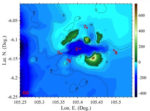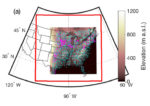Researchers at the University of Rhode Island are using XSEDE supercomputer to show that high-performance computer modeling can accurately simulate tsunamis from volcanic events. Such models could lead to early-warning systems that could save lives and help minimize catastrophic property damage. “As our understanding of the complex physics related to tsunamis grows, access to XSEDE supercomputers such as Comet allows us to improve our models to reflect that, whereas if we did not have access, the amount of time it would take to such run simulations would be prohibitive.”
TACC Powers Galaxy Bioinformatics Platform for COVID-19 Analysis
Researchers are using TACC supercomputers to power the Galaxy Bioinformatics Platform for COVID-19 analysis. More than 30,000 biomedical researchers run approximately 500,000 computing jobs a month on the platform. “Since 2013, TACC has powered the data analyses for a large percentage of Galaxy users, allowing researchers to quickly and seamlessly solve tough problems in cases where their personal computer or campus cluster is not sufficient.”
Jetstream and XSEDE resources available for pandemic research
As part of the worldwide effort to understand and contain the COVID-19 pandemic, Indiana University’s Jetstream, which offers cloud-based, on-demand computing and data analysis resources within the Extreme Science and Engineering Discovery Environment (XSEDE), is fast-tracking projects that respond to the crisis. “Through the COVID-19 HPC Consortium, Jetstream will provide vital high-performance computing resources. Specifically, priority use of IU’s Jetstream cloud system for analysis of the virus and searches for cures and vaccines. Jetstream offers cloud-based, on-demand computing and data analysis resources, in support of research related to COVID-19.”
Supercomputing the Expansion of Wind Power
Researchers are using TACC supercomputers to map out a path towards growing wind power as an energy source in the United States. “This research is the first detailed study designed to develop scenarios for how wind energy can expand from the current levels of seven percent of U.S. electricity supply to achieve the 20 percent by 2030 goal outlined by the U.S. Department of Energy National Renewable Energy Laboratory (NREL) in 2014.”
Supercomputing Ocean Wave Energy
Researchers are using XSEDE supercomputers to help develop ocean waves into a sustainable energy source. “We primarily used our simulation techniques to investigate inertial sea wave energy converters, which are renewable energy devices developed by our collaborators at the Polytechnic University of Turin that convert wave energy from large bodies of water into electrical energy,” explained study co-author Amneet Pal Bhalla from SDSU.
IBM & DOE Launch COVID-19 High Performance Computing Consortium
Today, IBM, in collaboration with the DOE, launched the COVID-19 High Performance Computing Consortium. “The consortium bring together an unprecedented amount of supercomputing power—16 systems with more than 330 petaflops, 775,000 CPU cores, 34,000 GPUs, and counting—to help researchers everywhere tackle this global challenge. These high-performance computing systems allow researchers to run very large numbers of calculations in epidemiology, bioinformatics, and molecular modeling in hours or days, not weeks, months or years.”
XSEDE Supercomputers Complete Simulations Pertinent to coronavirus, DNA Replication
Fundamental research supported by XSEDE supercomputers could help lead to new strategies and better technology that combats infectious and genetic diseases. “Chemical reactions, life, doesn’t happen that quickly,” Roston said. “It happens on a timescale of people talking to each other. Bridging this gap in timescale of many, many orders of magnitude requires many steps in your simulations. It very quickly becomes computationally intractable.”
CUDA-Python and RAPIDS for blazing fast scientific computing
Abe Stern from NVIDIA gave this talk at the ECSS Symposium. “We will introduce Numba and RAPIDS for GPU programming in Python. Numba allows us to write just-in-time compiled CUDA code in Python, giving us easy access to the power of GPUs from a powerful high-level language. RAPIDS is a suite of tools with a Python interface for machine learning and dataframe operations. Together, Numba and RAPIDS represent a potent set of tools for rapid prototyping, development, and analysis for scientific computing. We will cover the basics of each library and go over simple examples to get users started.”
IRIS and XSEDE to investigate the impact of research supercomputing
A partnership XSEDE and the Institute for Research on Innovation and Science (IRIS) will examine how access to advanced research computing resources and services available via XSEDE affect the collaboration networks and scientific productivity of participating researchers. “IRIS will link the IRIS UMETRICS dataset containing transaction-level administrative data on sponsored research projects from dozens of the nation’s leading higher educational institutions to data from XSEDE allocations. This will result in a new way to examine how access to supercomputers influences the way researchers collaborate with colleagues and the productivity of individuals and research teams.”
Podcast: Simulating Galaxy Clusters with XSEDE Supercomputers
In this TACC podcast, researchers describe how they are using XSEDE supercomputers to run some of the highest resolution simulations ever of galaxy clusters. One really cool thing about simulations is that we know what’s going on everywhere inside the simulated box,” Butsky said. “We can make some synthetic observations and compare them to what we actually see in absorption spectra and then connect the dots and match the spectra that’s observed and try to understand what’s really going on in this simulated box.”













